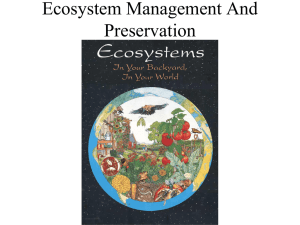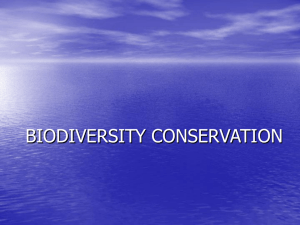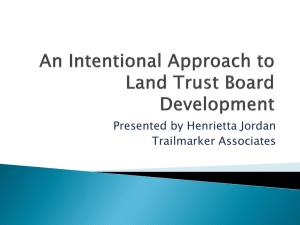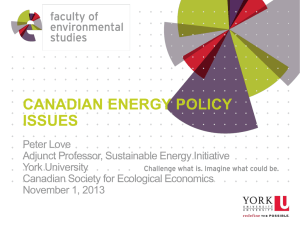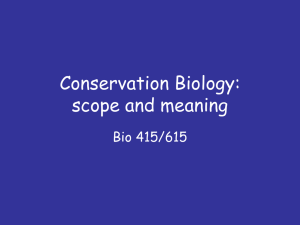Managing Biodiversity - SLC Geog A Level Blog
advertisement
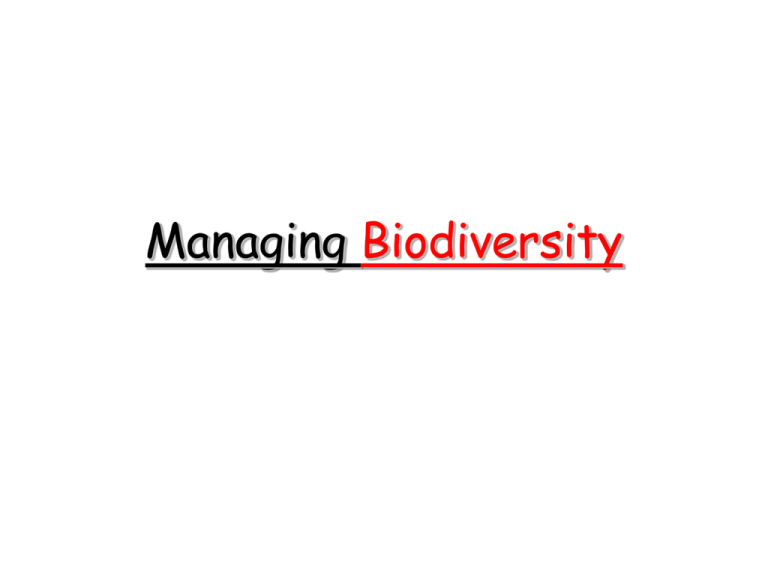
Managing Biodiversity The key players in management? Brainstorm ALL the players you think are involved Transnational and private enterprise Indigenous people Scientists and researchers Local and regional governments Players in ecosystem management International organisations Artists and poets NGOs stakeholders Special interest groups National governments Local farmers Individuals Global Players • There are 150 wildlife treaties in place • Such things require a number of nations to sign before becoming law • Most involve funding conservation work, designating protected areas, or regulating endangered species • The 5 most important treaties in place today are • RAMSAR Convention- wetland conservation signed 1971- adopted by 147 countries • World Heritage Convention- to designate and protect outstanding cultural and natural sites- signed 1972, by over 180 countries • The Convention on International trade in Endangered Speciessigned in 1973, adopted by 166 countries • The convention on the conservation of Migratory Species of Wild Animals was signed in 1979 and by 2005 adopted by 90 countries to prevent shooting of birds in passage • The UN Convention on the Law of the sea- ratified by 148 countries Other global players • • • • • • Transnational cooperation's are involved, have say in which goods/ services are mostly exploited- increasingly they are moving to greener strategies for long term benefit and to improve public image They also drive innovation and technology, sometimes for the common good, but sometimes to the detriment of the ecosystem involved Other international institutions which are involved- UN agencies, World Bank, World Trade Organisation and the International Tropical Timber Organisation Non government Organisations- such as Greenpeace and WWF provide vital biodiversity conservation WWF works in over 100 countries- it’s mission is to stop the degradation of the planets natural environment and build an environment where people live in harmony with nature Others are smaller such as FAN (A small NGO working in Eastern Bolivia to conserve biodiversity by using natural resources in a sustainable way). National Players • Government- regulate and facilitate • Regulation- establish and enforce laws to conserve genetic biodiversity, protect various areas and species and regulate damaging activities such as using polluting agro chemicals or releasing invasive species • They also manage natural resources providing clean air water or open space • They fund preservation conservation and development, often through taxes and subsidies • Positive incentives to conserve are increasingly used, e.g. paying farmers to be stewards of the landscape and to farm in environmentally friendly ways Local players • Indigenous people are often dependant on biodiversity for basic survival • For many local biodiversity has spiritual significance • Locals have good knowledge of local plants and their uses, e.g. traditional medicine • Local fishers/ farmers can conflict with conservationists because they live a subsistence lifestyle relying on the ecosystem for survival • Ecosystem management issues are increasingly in previously remote areas like the Amazon and Antarctica- as more people visit pressures arise • Some individuals can join together to form special interest groups- they can degrade delicate areas • Conflict can arise from scientists hunting for new drugs, species with indigenous people who just want to continue their existence Individual players • Most diverse group of all • All having individual morals, beliefs and needs on each ecosystem • In OECD countries ethical consumerism is increasing people buying dolphin friendly tuna. • Spiritual and recreational demands for new tourist destinations means areas like the Galapagos and Arctic are experiencing mass tourism. Strategies and policies Scientific Reserve Community wildlife management Wildlife Reserves and parks Economic development integrated into conservation Extractive reserves Tolerant forest management Exploitation with token protection How best to protect? • • • • • Total protection? Biosphere reserves Leave to exploit Conserve certain areas In the 60s total protection was favoured, in 80s local voices were heard and biosphere reserves were created leaving some land to locals and fencing off the rest. What problems with this approach? • In more recent times economic and social aspects of biodiversity more taken into account- ie ecotourism What is the spectrum of conservation strategies? There is a spectrum of conservation strategies available, from complete protection through various types of ‘sustainable development’ to commercially exploited areas where limited parts are protected …often for publicity! The total area of land and number of protected sites is increasing. Poland, Ecuador and New Zealand now have 25% of their land protected. What sort of protection? In the 1960’s total protection was the only method of conservation! In the 1980’s biosphere reserves were established with buffer zones…for use by local people 21ST Century conservation now means species protection, scientific reserves, as well as incorporating economic development with biodiversity. What factors is successful conservation influenced by? Demonstrate: What are the problems with the ‘total protection strategy’? WALT To understand the strategies and polices in place for management In LEDCs conflict between conservation and cutting people off from biodiversity Success Criteria Totally protected reserves can be focussed on for scientific purposes and fail to see that conservation is influence by social, economic, etc A – Examine the success/ failure of the polices and strategies at a range of scales Many schemes were based on political and economic boundaries where as ecosystems are defined by natural borders!! C – Describe and explain the strategies and their success rate Coordination from outside agencies which do not always know about needs of local people Activate: What are biosphere reserves? WALT To understand the strategies and polices in place for management Success Criteria A – Examine the success/ failure of the polices and strategies at a range of scales C – Describe and explain the strategies and their success rate Reserves are a popular strategy. Many are in favour of ‘corridor’ like reserves running north-south. Global warming drives species from the poles will still be protected! Many people feel that conservation should target ‘hotspots’. WWF favours a broad approach to save larger areas and more species. Some others feel we should concentrate in LEDCs where it would cost less and get better value for money. Sustainable Yield= key part of sustainable ecosystem management. It represents the safe level of harvest that can be hunted/ caught/ utilised without harming the individual ecosystem. How do they measure the sustainable level? • Maximum sustainable yield- greatest harvest that can be taken indefinitely while leaving the ecosystem intact. Harvesting wild plants, animals or fish is part of the subsistence lifestyle of indigenous people and is usually sustainable. • Over harvesting or overexploitation are usually the result of commercial rather than subsistence activity. When activities such as shooting elephants for ivory or harvesting shellfish and logging in natural forests- the targets and their habitats are under threat • Optimum sustainable yield- best compromise achievable in the light of all the economic and social considerations. This will not destroy the aesthetic or recreational value of the ecosystem and will therefore allow multiple use for the maximum benefit to the community. • In order to manage fish/ wildlife mathematical models have been developed to estimate the CARRYING CAPACITY (CC). This is maximum human population that can exist in equilibrium with the available resources (food, nutrients, etc). • The major problem is that the CC varies seasonally and over time can be reduced by Climate Change Intense competition for food Carrying capacity Population begins to be threatened by over harvesting MSY in practice No cover against predators Mortality high, population reproducti on low Population declines for natural reasons, more rapidly if over harvesting occurs Maximum sustained yield halfway between 0 and the CC OSY lower than MSY, so ecosystem still has high aesthetic value Carefully controlled harvesting allows population growth Sustainable Yields in the Southern Ocean • Managed since 1961 since the Antarctic treaty came into force. Before this they were exhausted and overfished. Several fin fish became extinct. A model was used to calculate the fishing yield. • Whaling is banned • No culling of fur or elephant seals • Limits placed on krill taking • Protection of penguins and other Antarctic sea birds, as they being in food web have an impact on sea stocks • Environmental protection in place- no military action or waste dumping, so air pollution kept to minimum • Few visitors, mainly scientists and some seasonal tourists, but little noise pollution Southern ocean SYM – A 3 prong approach! * Single species approach sets limits for harvesting individual species that are indefinitely sustainable. * Ecosystem approach involves considering harvested species both on their own and in relation to dependant species and whole environment. * Precautionary principle aims to model consequences of any planned expansion of catches before it is permitted. Case study: CAMPFIRE approach – Why did it collapse? Under British colonial rule large sections of indigenous population in Zimbabwe were forced to live in communal areas - tribal trust lands. Communal Areas Management Programme for indigenous resources (CAMPFIRE) project was set up in the late 1980’s. It was aimed at long-term development, management and sustainable use of natural resources in each communal area. Case study: CAMPFIRE approach The responsibility was placed with local people, whilst allowing them to benefit directly from the exploitation of resources. ‘Bottom Up’ Approach – varies and advice is given by the Zimbabwe Department of National Parks and Wildlife Management. Case study: CAMPFIRE approach Many of the schemes made money from biggame hunting at sustainable yield levels…this money was then fed back into the community. The economic collapse of Zimbabwe undermined the whole scheme. Loss of staff, lack of funding, poaching, hunger saw it collapse. Demonstrate: Questions… Describe what sustainable yield means (5) Explain how the Southern Oceans and CAMPIRE are examples of sustainable management. (10) Conservation priorities? • Some want to target HOTSPOTS as they are areas of maximum diversity and are under greatest threat • WWF favours a broader approach in which representative areas of land and sea known as ecoregions are targeted to save a max of variety of habitats and species • Some say focus should be a poorer regions of world as costs are lower. • Some question focus of conservation on high interest animals like Pandas and tigers Restoring degraded areas • The ultimate conservation challenge • i.e. Recreating wetlands • Or linking fragmented reserve areas to make larger reserves easier to manage and more biodiverse • These schemes rely on how degraded land is the more degraded and polluted the harder it is • An example of this is the Great Fens recreation project in East Anglia, UK. Conservation • Other approaches to conservation, ex situ conservation, e.g. captive breeding of endangered animals in zoos. • Zoos also contain biodiversity banks such as seed banks for plants • Several species have been saved in this way such as Scimitar horned Oryx, bred at Marwell Zoo and re released into Arabia • Giant pandas are also being bred in captivity to increase numbers • Some people do not like zoos feeling sorry for captive animals, but they play a vital role in education of people and allowing people to see animals they otherwise may not see Task 1) Produce short fact files on each of the varying management strategies a) Buffer zones b) Biosphere reserves c) Global agreements like CITES d) Gene banks e) Restoration f) Captive breeding 2) Assess the relative advantages and disadvantages of each method of management •IUCN Red List of Threatened Species is considered the most comprehensive record of the conservation status of plants and animals. •Essentially precise criteria is utilised by different countries and organisations to evaluate the extinction risk of thousands of species and subspecies. • These criteria are relevant to all species and all regions of the world. • Records are continually being updated. • The IUCN aim to convey the urgency of conservation issues to the public and policy makers, as well as help the international community try and reduce species extinction. • The Living Planet Index (LPI) is an indicator of the state of global biological diversity, based on trends in vertebrate species- fish, amphibians, reptiles, birds mammals- from all around the world. • By tracking wild species, the Living Planet Index is also monitoring the health of ecosystems. • The information can be used to define the impact humans are having on the planet and for guiding actions to address biodiversity loss. •The WWF developed a system of eco-regions. • 200 Eco-regions were identified. • They are deemed the most biologically distinct terrestrial, freshwater, and marine ecosystems on the planet and subsequently are to be protected and conserved to ensure species, habitats and ecological processes continue. • The eco-regions identified are to be representative of all ecosystems of that type. • World Resource Institute – Earthtrends • Millennium Assessment • Find out how they conserve biodiversity. Write a short paragraph about each. a) Explain the distribution of the world’s terrestrial and marine hotspots in Figure 3. 1 • Define hotspot 2 • Terrestrial hotspots - % land covered. Geographical location of majority of hotspots. Examples. Biodiversity Threats 3 • Marine hotspots- types of ecosystem. Examples. Threats. 4 • Explanation – detailed locations mentioned. Explains reasons for high biodiversity. Highlights range of ecological niches, complex food chains, details of endemism and reasons for the range of threats. b) Evaluate the relative advantages and disadvantages of the ‘hotspot’ approach to biodiversity management (compared with other strategies) (15) 1 • For hotspot approach 2 • Against hotspot approach – against protectionist approach 3 4 • Alterative mode of conservation • conclusion

